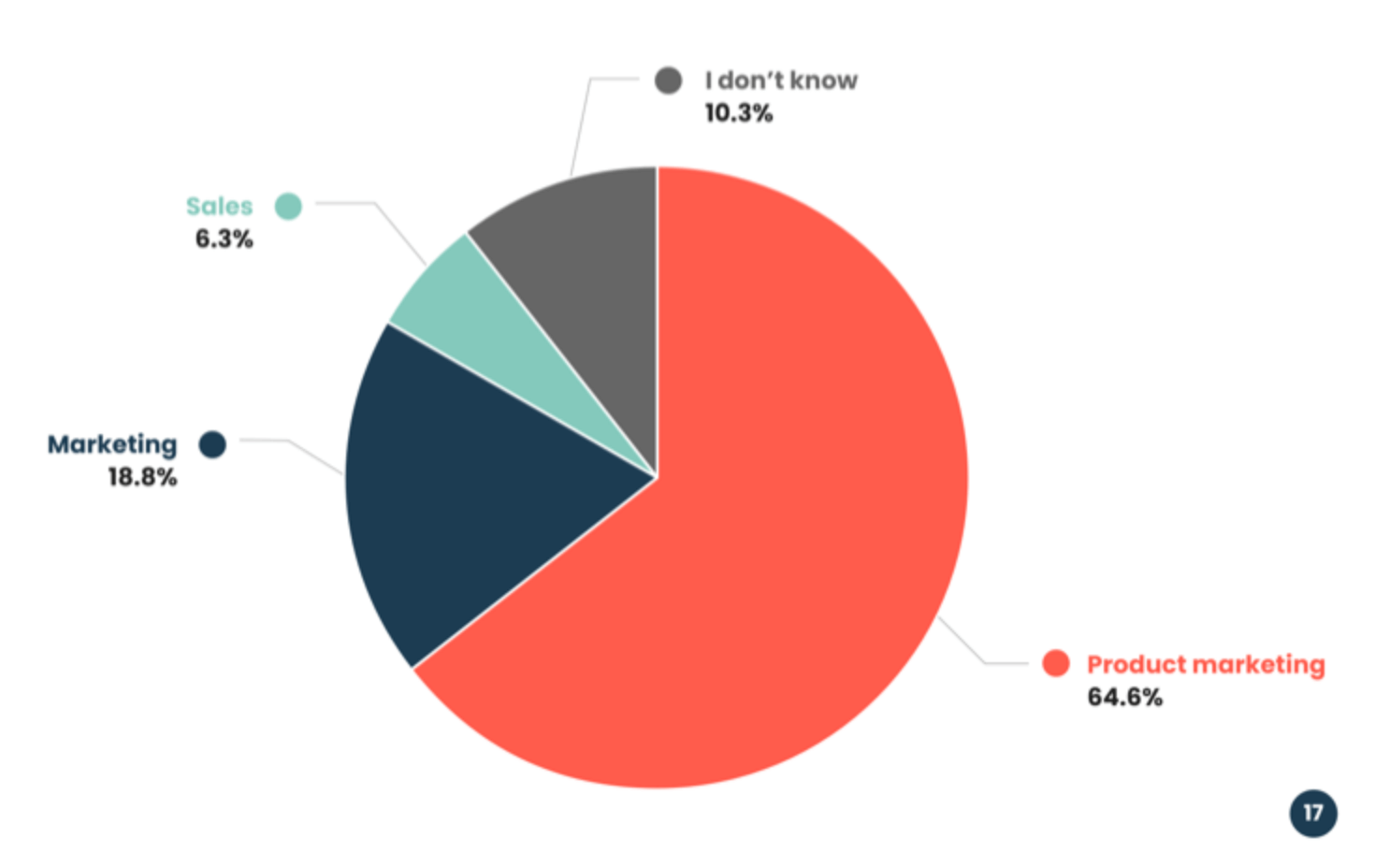Business is like the world itself: it never stops evolving, it’s super-competitive, and ruthless, to say the least.
You need to make sure your sales reps are equipped for what’s around the corner; if you fail to do so, you’re begging to fall flat on your face.
Like a knight in shining armor, you - as a product marketer - can give your sales teams the confidence they need to tackle the toughest of challenges, with the help of sales enablement sessions.
In this article, we'll cover key areas, including:
- What they are
- How to plan them
- Who owns them
- How to get the most from them
- Tips for improving engagement
What are sales enablement sessions?
Sales enablement is the process of ensuring sales reps have the resources they need to secure more deals for your company. Materials may include content, tools, knowledge, and information to ensure they can sell the product or service to prospects in a more effective way.
The process is a crucial part of any product marketing project; it’s the point at which the key components align and your blood, sweat, and tears pay dividends.
Sales enablement sessions are the ideal opportunity to put the sales reps on your team in the right frame of mind and reps should be encouraged to ask questions to establish a firm understanding of areas including:
- How your product works,
- How to position your product,
- Your USPs (unique-selling-points),
- Rival products.
The key takeaways for a sales enablement session are by no means set in stone and will be determined by the timing of when an event is taking place.
For example, if it’s in the run-up to a new product launch, the emphasis should be on elements such as product pricing, methods your reps can use to sell it, etc. On the other hand, if the session is taking place following the overhaul of a product, the focus should be on product repositioning. Finally, events on new personas need to focus on the characteristics of these profiles.
When a product marketer takes the time to plan in-depth sales enablement sessions and provide their team with high-quality materials, this equips a sales rep with the quintessential skill sets to interact with prospects effectively.
And, as we all know, a confident sales rep is an effective sales rep.
How to plan sales enablement sessions
So, you may now know what sales enablement sessions are, but what do you need to consider when you’re planning your sessions?
Set goals
When planning your sales enablement sessions, always have one thing firmly in your sights: the goal. It’s part and parcel of product marketing to set measurable goals, and this ought to be the case when you’re getting ready to kickstart your sessions.
As we’ve said many times, focusing on goals you can’t measure doesn’t make sense. You need to be able to assess:
- What went well so you can continue to implement this in future practice, and
- What didn’t work, so you don’t make the same mistakes.
High-school teachers set learning objectives for their students, and you need to do the same for your sales reps.
Decide what you want them to take away when they’ve finished with the session. Then, conduct the acid test; if they've paid attention and engaged with activities, yet failed to learn something tangible, then it's time to go back to the drawing board.
Consider your audience
A master should be led by the protegee, not the other way around, and this motif also applies to sales enablement sessions.
Put yourself in the shoes of the attendee, view things from their perspective, and plan accordingly. For example, how much experience will your reps need for the content to make sense? This'll influence the goals you set for your session, and outline the parameters for what constitutes success when you’re analyzing your results.
Think about constraints
Some things aren’t always plain sailing, and you’ll need to plan ahead and think about potential obstacles you could potentially encounter during your session.
There’s no doubting the benefits of sales enablement, but similarly, bumps in the road may include:
- Juggling multiple projects,
- Tight time constraints,
- Aligning your deadline with other teams, to coincide with sales updates, etc.
Establish your budget
Product marketing teams aren’t provided with a bottomless pit of money to work with. A set budget is put in place and you’ll have to work within a certain set of parameters to accomplish your goals.
Thorough planning is central to success and your budget will have an impact on how you choose to plan your session. For example, if you have some cash at your disposal, you could invest in resources to improve the interactivity of the attendees.
On the other hand, if you’re working with your hands tied, you’ll have to be a little more innovative to achieve the desired effect.
Size of the event
The size of a sales enablement session will vary depending on the size of your organization. Nonetheless, it’s something you need to consider to be sure you’re putting the necessary steps in place to accommodate your sales team.
NB: If the event isn’t big enough, it won’t tick all the boxes, but if it’s too large, this could be a drain on time and resources that could’ve been invested elsewhere.
The regularity of sessions will also depend on the size of your company. In some cases, a session once a quarter will suffice, needs to be held once a quarter, and you may be able to coincide your event with events taking place at the same time.
It can also be helpful to tie your session to existing sales meetings, which you're already attending as a guest speaker. Alternatively, you can offer your services on a more regular basis, so people can book in beforehand, rather than heading into a session without any anticipation of what you can expect.
This will inevitably vary depending on your setup. If you’re launching new products every other month, sales enablement sessions will be more of a regular occurrence. On the other hand, if you have fewer launches penciled into your calendar, you’ll need to host them less frequently.
Who owns sales enablement?
There’s no definitive answer as to who should host sales enablement meetings. The setup varies between different companies.
Nonetheless, we reached out to product marketers and did some digging, to see where the responsibility for sales enablement meetings fell.
As part of the Sales Enablement Landscape Vol.2 report, we asked respondents who owned sales enablement at their company.
The majority said the task sat with product marketing (64.6%), while 18.8% said marketing was responsible. A further 6.3% said sales owned the process, while 10.3% weren’t sure.

This represents a shift from the trends from 2020's sales enablement survey, in which 56.3% of respondents said marketing owned the process, with 23.4% saying it was a responsibility held by product marketing.
Regardless of who conducts sales enablement sessions, how can you be sure you’re getting the most out of your meetings?
How to get the most out of your sales enablement sessions
To ensure everyone gets the most out of the time, here are some tips you can implement to boost the effectiveness of your sales enablement session:
Collaborate
Internal communication is at the heart of a successful sales enablement session. You should collaborate with sales leadership, to ensure your message is contextualized, and there are a variety of tools available to help you improve your synergy with other departments.

It’s deemed good practice to avoid the scheduling of training events in the last month of the quarter. This time is typically devoted to closing sales opportunities, as opposed to training and development.
Share diverse content
Having established your goals and selected an appropriate time in the calendar, it’s time to put together your content.
Some companies have a team whose sole purpose is to focus their attention on refining resources such as scripts, battlecards, etc. that’ll be used in sales enablement sessions.
Granted, this isn’t the case for every org, but this doesn’t mean you need to miss the boat. You can join forces with your stakeholders to deliver a mix of PMM deliverables and set the context for people likely to be attending your sales enablement session.
Remember, when you’re liaising with stakeholders, be sure to adopt their language, and approach things from their angle.
People are consuming content in different ways. Therefore, where possible, convert your content into a digestible format such as a podcast, or video.
This'll allow team members in attendance to revisit the content at a later stage and pick up on any takeaways they may have missed the first time around.
On-demand platforms are also useful for people who may have missed training, with our very own PMMfixx a perfect example of this principle in action.
Never make assumptions
Never assume your target audience will do what you want them to do if you don't tell them.
If you don’t explicitly outline what they need to do with a CTA, then the chances are, that they won’t do it.
Want them to download something? Tell them to 'download X.
Want them to use a resource in their next client meeting? Tell them ‘use X in your next client meeting’.
Tie these leading/lagging indicators and key metrics to the end goal, because if it isn’t measurable, you can't track success.
Select an appropriate format
With an assortment of formats on the table, you should also consider which format works best for your sales reps.
For example, a passive classroom setting focuses primarily on information exchange. This is considered to be particularly relevant to visual and/or auditory learners, given its emphasis on using resources such as PowerPoint, as well as an emphasis on note-taking.
While this method will be useful in instances where you’re revealing your insights from testing, and so forth, a workshop set-up would be a more suitable approach for kinaesthetic learners, who respond to a more practical approach.
Multi-touch learning programs can also be implemented, whereby people need to complete pre-reading before they’re able to engage in tasks, or assignments are used via an eLearning platform. This method is commonly used for larger initiatives when people are breaking into new industries or creating new personas.
It’s useful to ameliorate training styles, combining elements of the aforementioned types to fine-tune and polish instructor-led training, commonly taking place within a classroom environment, or use observation methods whilst ‘on-the-job’ to ensure everyone’s well-equipped to work in the role itself.
This section ties in nicely with engagement amongst your sales team.
How to improve engagement during sales enablement sessions
We've all had a teacher who had zero charisma, taught dull lessons, and who couldn't inspire the class. In cases such as these, students never fulfill their optimum potential.
This is why it’s essential to keep your sales reps engaged in your sessions. If they’re bored by what you’re telling them, there’s a strong likelihood that what you’re saying will go in one ear, and straight out of the other.
Pull out all the stops to keep your sessions riveting, engaging, and relatable. Ask yourself what you’d want from a session; if you find a task laborious, the chances are, your attendees will, too.
Encourage questions
Discussions and interactivity need to be used wherever possible. This'll improve the atmosphere amongst the group, and create an environment conducive to learning.
Oftentimes, people learn more by asking questions, but never force people into a corner - allow them to adjust at their own pace.
Moreover, nobody likes being lectured to. To combat this issue, try role-play exercises to inject some fun into the group. This is a fantastic way to bring people together and transform robotic experiences more memorable.
Use anecdotes
Anecdotes are a great way to bring an idea or concept to life. While you may say your product is the best thing since sliced bread, you’re bound to sing its praises.
Instead, use active testimonials or customer case studies to illustrate your point. Not only will this give you credence, but the chances are they’ll relay this to prospective customers who may need a slight nudge over the line.

Use gamification
Gamification is also a powerful method used by sales teams. For example, the top weekly sales rep may be given a $100 Amazon voucher, while the second and third may get $50 and $25, respectively.
This is a common method used to drive competition, convert leads into customers, and generate revenue.
It’s human nature to have a competitive edge, and this is a trait that’s particularly common amongst sales professionals.
Use it to your advantage.
Don’t overload your sessions
You wouldn’t walk into a meeting with Hollywood executives and pitch a romantic horror movie, with a dash of comedy and a sprinkling of sci-fi.
Apply this same motif to your sales enablement sessions. Don’t try and cram in a bit of product features here, benefits there, and pricing in between. If you try to include too much into a short space of time, this will hinder the quality of your session.
Don't forget: you’ve got a 14-minute window to make an impact before people’s attention begins to wander. Make every second count.
Be a good role model
You never see a game show host with a face like a bulldog chewing a wasp. They’re all smiles, and so are the guests taking part.
Positive vibes are infectious; if your reps see you’re enthusiastic about the session, then the majority of the people attending will respond favorably.
On the other hand, if your body language isn't inspiring and you emit negativity, this’ll rub off on your team.
So, familiarize yourself with these tips and you’ll be a-OK:
- Do a practice run,
- Always be prepared,
- Use prompts as a safety blanket,
- Assert yourself both physically and vocally,
- Sit or stand upright and use gestures,
- Be mindful of your facial expressions,
- Speak confidently and loudly (without bellowing!)
- Make eye contact,
- Encourage audience participation,
- Speak clearly,
- Breathe! Take a swig of water if you need it.
Wanna learn even more on the subject? We’ve got you covered. There’s a whole section dedicated to sales enablement in Product Marketing Core, and tons of tried and tested templates in our membership plans.


















 Follow us on LinkedIn
Follow us on LinkedIn





.svg)
Start the conversation
Become a member of Product Marketing Alliance to start commenting.
Sign up now